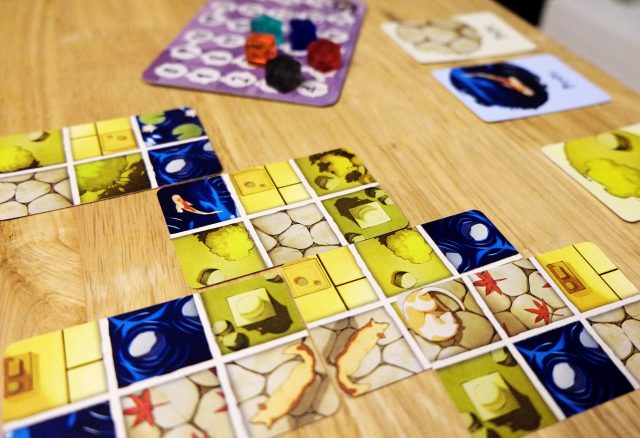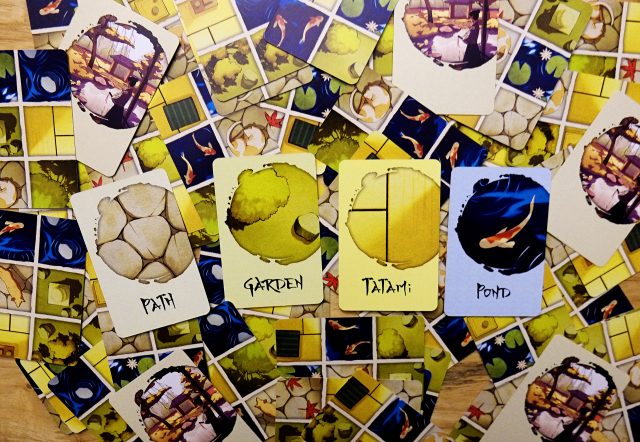Over the last handful of years I’ve really enjoyed the smaller and lighter fare that designer Hisashi Hayashi has been putting out – String Railway, Zooscape, Rolling America, Sail to India and the like. I certainly expected no less of recent (re-release) Samurai Gardener, through Osprey Games. Simple gameplay and tile laying are bound to grab my attention, so let me tell you a little more!
Samurai Gardener is truly not much more than a deck of cards and a scoretrack with player pieces – it’s that simple, out of the box. And it’s lightning quick to play, too! Part real-time race against your opponents and part puzzley placement of cards, it’ll be over before you know it – and before you’ve gotten to really beautify that garden! Starting with one of the building cards randomly dealt out, you will be trying to make groups of certain types of blocks with cards you grab (literally) every round. The start player deals out as many building cards from the deck as there are players, says “Ei, ei!” – and then when everyone is ready, they’ll shout “oh!” and all rush to cover up the card they want with their hand. If someone beats you to it, you have to think quickly to claim whatever’s left – hopefully it won’t mess up your plans too badly.
 Much like Honshu, you’ll be placing cards to make groups of a type in order to get points – you can choose to overlap or not depending on what works best for you. Rather than building up to end-game, you score out throughout the game when you decide to claim a group. Say I’ve just placed by fourth card of the game, and by doing so have lined up 5 squares of the tatami type – I can choose to score that, get 4 points and then flip over my tatami marker card. Until the other 3 types are scored, I can’t choose to score tatami again, and have to work on the others until they’re all flipped, resetting them all. This makes adding to your layout and grabbing cards quite the back and forth balancing act of not blocking opportunities for yourself. Especially when you can add to already existing groups but can’t cover them up when adding to your tableau. Very tricky, indeed. If you manage to line things up nicely to play a card that scores out two groups at once, there’s even bonus points in it for you. I certainly haven’t met this luck yet, I’m a bit of a black thumb when it comes to samurai gardening, it seems.
Much like Honshu, you’ll be placing cards to make groups of a type in order to get points – you can choose to overlap or not depending on what works best for you. Rather than building up to end-game, you score out throughout the game when you decide to claim a group. Say I’ve just placed by fourth card of the game, and by doing so have lined up 5 squares of the tatami type – I can choose to score that, get 4 points and then flip over my tatami marker card. Until the other 3 types are scored, I can’t choose to score tatami again, and have to work on the others until they’re all flipped, resetting them all. This makes adding to your layout and grabbing cards quite the back and forth balancing act of not blocking opportunities for yourself. Especially when you can add to already existing groups but can’t cover them up when adding to your tableau. Very tricky, indeed. If you manage to line things up nicely to play a card that scores out two groups at once, there’s even bonus points in it for you. I certainly haven’t met this luck yet, I’m a bit of a black thumb when it comes to samurai gardening, it seems.
Once a player reaches 25 points or the building card deck is exhausted, the game is over. This keeps the timing of the game quite tidy no matter how many players, which is great. I think the speed element of the card grabbing phase really helps in keeping this game quick, but I have to say I wasn’t a huge fan of that method. I understand why it was used, but I would rather something a little more laid back for this sort of abstract puzzle/pattern game. When Samurai Gardener was released as Edo Yashiki – and because it was tough to find and people didn’t want to wreck cards by slapping them – there’s an alternative to the speed-round which involves a blind bid suggested by someone on the Board Game Geek Forums. A house rule for the meeker of us out there, perhaps?
 Despite the speed element (which doesn’t completely ruin the game for me, let’s be honest!), I really enjoy the puzzle of this game. And for what is an abstract game, it’s nice to see a thoughtful theme that inspired it – there’s even a short introduction in the beginning of the rulebook about the history of lords creating grand gardens in their houses near Edo Castle. It’s also refreshing that a game with a Japanese theme is created by a Japanese designer – I think there’s quite a lot of co-opting of Japanese history and culture in game design due to how fascinating it can be. I’d like to see less “orientalism” in games and more representation of designers from varied backgrounds bringing their own connections and culture to cardboard like this game. Of course in Hayashi’s case, myriad themes to cardboard. I must say, the art by Kevin Hong is a really bold and lovely style that suits the theme nicely, and the detail on each of the squares is wonderful. Cats on the path, koi in the pond! Delightful.
Despite the speed element (which doesn’t completely ruin the game for me, let’s be honest!), I really enjoy the puzzle of this game. And for what is an abstract game, it’s nice to see a thoughtful theme that inspired it – there’s even a short introduction in the beginning of the rulebook about the history of lords creating grand gardens in their houses near Edo Castle. It’s also refreshing that a game with a Japanese theme is created by a Japanese designer – I think there’s quite a lot of co-opting of Japanese history and culture in game design due to how fascinating it can be. I’d like to see less “orientalism” in games and more representation of designers from varied backgrounds bringing their own connections and culture to cardboard like this game. Of course in Hayashi’s case, myriad themes to cardboard. I must say, the art by Kevin Hong is a really bold and lovely style that suits the theme nicely, and the detail on each of the squares is wonderful. Cats on the path, koi in the pond! Delightful.
I think overall, Samurai Gardener is a great game in its concept even though I’m not excited about certain parts of its execution. I would certainly think about your feelings on speed games when going into this – but it’s not the game 100%, so bear that in mind! I’d say the planning and the puzzling is the standout part of this game and it is a delight. Warm up for your game night by getting your garden in shape, and get Samurai Gardener to the table.
—
Samurai Gardener is a game for 2 – 5 players which plays in about 15 minutes. Designed by Hisashi Hayashi with art by Kevin Hong, it is currently published by Osprey Games, who we’d like to thank for sending us a copy to try!
Comments
No comments yet! Be the first!